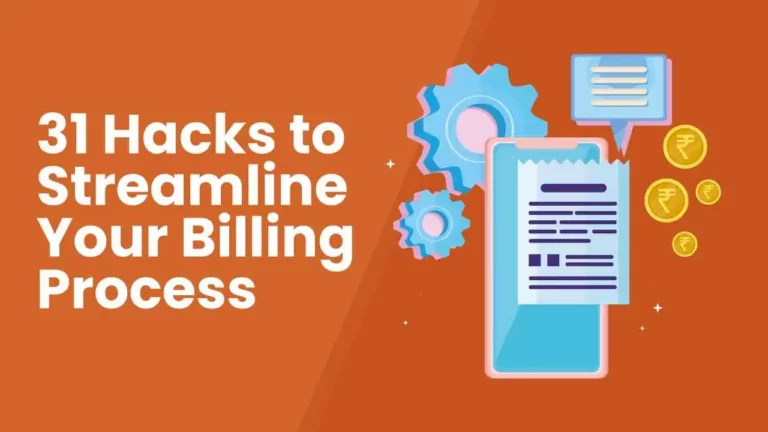31 Hacks to Streamline Your Billing Process
Are you spending countless hours on billing tasks, drowning in paperwork, and dealing with late payments? It’s time to streamline your billing process and reclaim your valuable time. Here are 31 hacks to upgrade your billing process and bring efficiency to your financial operations. From automating invoices to implementing cutting-edge technology, we’ve got you covered. Get ready to unlock the secrets that will transform your billing woes into smooth sailing. So buckle up because it’s time to embark on a journey towards a more streamlined and hassle-free billing process. Let’s dive in and discover the game-changing hacks that will revolutionise the way you handle your invoices and payments.

1. Use Invoice Templates
Create standardised invoice templates to speed up the invoicing process and maintain consistency. Custom invoices are one of the professional ways to present your business.
2. Provide Detailed Invoices:
Ensure your invoices contain all necessary details, including itemised charges, quantity, unit price, and applicable taxes or discounts.
3. Automate Invoicing
Use billing & accounting software to generate and send invoices to clients automatically.
4. Establish a Standardised Billing Schedule
Create a consistent billing schedule to ensure timely invoicing and payment processing.
5. Set up Recurring Billing
For clients with regular payments, establish recurring billing to save time on manual invoicing.
6. Implement Electronic Billing:
Transition to electronic billing to eliminate paper-based processes and reduce manual errors. Electronic billing allows you to create, send, and receive invoices electronically, facilitating faster delivery and payment processing.
7. Train Employees on Billing Procedures
Educate your staff on billing processes and best practices to minimise errors and increase efficiency.
8. Optimise Invoice Delivery
Determine the most efficient and cost-effective method for delivering invoices to clients, whether by email, Whatsapp, or electronic portals.
9. Conduct Regular Billing Audits
Regularly review your billing process, invoices, and financial records to identify any discrepancies or areas for improvement. Make necessary adjustments to improve efficiency.
10. Establish a Dedicated Billing Team
Assign a dedicated team or person responsible for managing billing tasks to ensure efficiency and accountability.
11. Set Clear Payment Terms:
Clearly communicate payment terms, including due dates and penalties for late payments, to avoid confusion and delays.
12. Send Timely Payment Reminders
Automate payment reminders to ensure clients stay aware of their outstanding balances.
13. Offer Flexible Payment Options
Allow clients to pay invoices through various methods, such as credit cards, bank transfers, or digital wallets.
14. Use QR Code Scanning
Incorporate barcode or QR code scanning on invoices and receipts to streamline payment processing and data entry.
15. Offer Online Payment Options
Offer online payment methods to simplify the payment process and reduce the manual handling of cheques and cash.
16. Offer Discounts for Early Payments
Encourage prompt payments by providing incentives such as early payment discounts, which can help improve cash flow.
17. Implement Automated Late Fees
Use automated systems to apply late fees or interest charges on overdue payments, saving time and effort.
18. Enable Real-Time Payment Notifications
Set up systems to receive real-time notifications when payments are received, allowing for immediate updates and reconciliation.
19. Implement Automatic Payment Reconciliation
Use billing software to automatically reconcile incoming payments with corresponding invoices, reducing manual effort and errors.
20. Monitor Payment Trends
Analyze payment patterns to identify and address any issues or recurring delays promptly.
21. Integrate with Accounting Software
Connect your billing system with your accounting software to streamline the flow of financial data. A billing system having both billing and accounting functions is of much help.
22. Invest in Cloud-based Accounting Software
Use cloud-based accounting software that provides real-time access to financial data, allowing for seamless collaboration and immediate updates.
23. Leverage Data Analytics
Utilise data analytics tools to gain insights into billing trends, payment cycles, and areas for improvement.
24. Use Electronic Signatures
Implement electronic signature solutions to eliminate the need for printing, signing, and scanning paper documents.
25. Simplify Expense Tracking
Provide an easy way for clients to submit expense reports electronically, minimsing manual data entry.
26. Implement Mobile Billing Solutions
Use mobile billing apps or tools that allow you to create and send invoices on the go, increasing flexibility and speed.
27. Standardise Billing Codes and Descriptions
Establish a standardised coding and description system for products or services to streamline invoice creation and improve clarity for clients.
28. Offer Self-Service Account Management:
Provide clients with self-service options to update their payment information, view past invoices, and make payments independently.
29. Integrate with Customer Relationship Management (CRM) Software
Integrate your billing system with your CRM software to have a holistic view of customer interactions, invoices, and payment history.
30. Utilise Cloud-based Storage
Store all billing-related documents in the cloud for easy access and collaboration.
31. Centralise Customer Data
Maintain a centralised database with customer information, payment history, and billing preferences.
Remember to assess your specific business needs and adapt these hacks accordingly. Each organisation’s billing process may vary, so it’s important to tailor these strategies to fit your unique requirements and goals.

